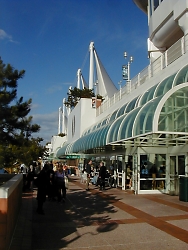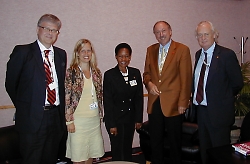FIG at the 3rd World Urban Forum
Vancouver, Canada 18-23 June 2006
|

Vancouver Congress and Exhibition Centre offered the venue for the 3rd
World Urban Forum.
|

President
Holger Magel together with Mrs. Anna Tabaijuka
and Mr. Lars Reutersward (right) and Mr. Bengt Kjellson
and Ms. Ann Jennervik from Sweden to discuss FIG and UN-Habitat
co-operation at the FIG 2008 in Stockholm. |
The 3rd Session of the World Urban Forum attracted some 10,000
participants from over 100 countries to Vancouver, Canada 18-23 June 2006.
This was more than double to the previous meeting in Barcelona and more than
2,000 more than expected by the organisers. Especially number of
participants representing professionals, academia and NGOs and grass root
organisations exceeded the estimates. The meeting paved the way for a new
drive forward on the international urban agenda in a world of rapidly
growing cities. Just as the Habitat I Conference in Vancouver in 1976 placed
local community concerns on the international agenda and highlighted the
critical importance of inclusiveness, the Forum in Vancouver, 30 years
later, lived up to its promise of moving ideas to action. The meeting
symbolized inclusiveness, with balanced participation from public, private
and civil society sectors. Compared to previous sessions of the Forum, there
was a notable increase in private sector participation.
This time, it was from Vancouver that a new message resonated: the urban
population of developing countries is set to double from 2 to 4 billion in
the next 30 years. In the same time span, the developed world's urban
population is projected to rise by only 11 percent.
The quest for innovative ideas and practical solutions was underscored in
the six Dialogues, 13 Roundtables and more than 160 Networking Events.
Key points of agreement to emerge from the Third Session of the World
Urban Forum in Vancouver 2006 were:
- The need for all urban players – citizens, local governments, state
and provincial governments, national governments, the private sector and
civil society organizations – to work harder to solve urban problems and
challenges. There was widespread agreement that they all must do their
part, rather than simply transfer responsibility to others.
- That risk-taking and the pursuit of innovation must characterise
municipal leadership if cities are to achieve sustainable development.
Vancouver's example in taking the lead in such areas as air and water
quality, public transit and planning was mentioned often in this context.
- Agreement that appropriate engagements, partnerships and relationships
need to be built in an inclusive manner to better understand challenges
and develop practical solutions. Participants from many parts of the world
presented examples that can serve as guideposts for these strategies.
- The importance of transparency and accountability. Citizens need to be
informed of challenges and steps taken by governments to address them.
Transparency goes hand-in-hand with accountability, which speeds up the
process of enhancing actions that work and curtailing those that do not
work.
Read more at:
http://www.unhabitat.org/wuf/2006/wuf_story12.asp
FIG was represented in the World Urban Forum by delegation
led by President Holger Magel. Other representatives of FIG included
Vice President Ken Allred, Ms. Jenny Whittal (South Africa)
and the FIG Director, also some other actives from FIG participated the
conference and its preparations. Preparatory meeting included the FIG
Commission 7 organised Expert Group Meeting in Bangkok and Global Land Tool
Network in 2005.
President Magel represented in two sessions organised by
UN-Habitat on the Global Land Tool Network. The first session was a
Networking Event on the GLTN - Development of pro poor land tools. FIG is
one of the main professional partners of UN-Habitat on this major initiative
for the next few years. The GLTN was officially launched after this session
by the newly appointed Deputy Executive Director of UN-Habitat, Mrs. Inga
Björk-Klevby. The GLTN Network has been mobilised by Dr. Clarissa
Augustinus and Mr. Ulrik Westman. Read more about GLTN at
www.gltn.net.
The Global Division of UN-Habitat organised also a round
table on gendering land tools. This session was opened by Mrs. Anna
Tibaijuka, Executive Director of UN-Habitat. FIG's contributions were
made by President Magel and Ms. Jenny Whittal. The focal point for
the Gendering Land Tools is Dr. Siraj Sait.
The third major event for FIG during the week was the Networking Event
organised by the Habitat Professionals Forum. This event "Public
Engagement: The Inclusive Approach" was attended by more than 100
delegates, so that the room was overcrowded and some delegates had to sit on
the floor. At this two-hour session five presentations were made. The
facilitator of the session was Prof. Magel, Chair of the Habitat
Professionals Forum. Speakers were Dr. Irene Wiese - von Ofen (IFHP),
Prof. Matthias Reichenbach-Klinke, Prof. James R. Taylor
(IFLA), Ms. Christine Platt (SAPI) and Mr. Selman Ergüden
(UN-Habitat). read more about this session on web site:
www.habitatforum.org.
During the WUF there was also the meeting of the Steering Committee of
the Habitat Professionals Forum. At this meeting future activities including
participation to the 20th Meeting of the Governing Council in 2007 and at
the 4th World Urban Forum in Nanjing, China in 2008 were discussed.
During the conference also the initiative of organising a
joint FIG / UN-Habitat Seminar in Stockholm in conjunction to the FIG
Working Week 2008 was launched. This event and initiative has been prepared
between Sweden Government, the Swedish FIG member association SLF and FIG,
especially commission 9. It will focus on slum upgrading and the importance
of financial mechanisms. FIG will consider how to link this initiative to
the other joint activities with UN-Habitat. At the meeting with Executive
Director Tibaijuka and Director Lars Reutersward full support from
UN-Habitat was confirmed to this project. The focal points for this project
are Lars Magnusson, Bengt Kjellson and Ann Jennervik
from Sweden.
Presentations of the FIG representatives:
-
Closing Remarks at the Habitat Professionals Forum's Networking Event
"Public Engagement: The Inclusive Approach" by Chair of the Habitat
Professionals Forum, Univ.-Prof. Holger Magel, FIG President, at the 3rd
World Urban Forum, Vancouver, Canada 22 June 2006.
-
Opening Remarks at the Habitat Professionals Forum's Networking Event
"Public Engagement: The Inclusive Approach" by Chair of the Habitat
Professionals Forum, Univ.-Prof. Holger Magel, FIG President, at the 3rd
World Urban Forum, Vancouver, Canada 22 June 2006.
-
Statement at the GLTN Round Table on Gendering Land Tools
by FIG
President Professor Dr.-Ing. Holger Magel, at the 3rd World Urban Forum,
Vancouver, Canada 21 June 2006.
- Presentation by Jenny Whittal
at the at the GLTN Round Table on Gendering Land Tools at the 3rd
World Urban Forum, Vancouver, Canada 21 June 2006.
-
FIG Statement at the Global Land Tools Network (GLTN) - Networking Event
at the 3rd World Urban Forum, Vancouver, Canada 20 June 2006.
Picture
Gallery
|
























